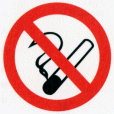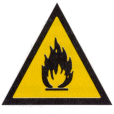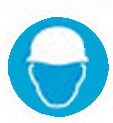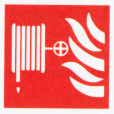How To Draw A Caution Sign
Health and Safety (Prophylactic Signs and Signals Regulations) 1996
These Regulations brought into force the EC Safe Signs Directive 92/58/EEC on the provision and utilize of safety signs. The safe signs directive was adopted by all European Union member states on 24 June 1992, which recognised the need for all workplaces to have hands recognisable signs and symbols relating to rubber matters and encourage the standardisation of prophylactic signs throughout the member states of the European Union so that prophylactic signs, wherever they are seen, accept the same meaning. In this country, the Directive has been implemented through the Health and Safety (Safety Signs and Signals Regulations) 1996. These regulations apply to all places of work covered by the Wellness and Safety at work etc Act 1974.
The Regulations cover various means of communicating health and safety information. These include the employ of illuminated signs, hand and acoustic signals, due east.g. fire alarms, spoken communication and the marker of pipe piece of work containing unsafe substances. These are in add-on to traditional signboards such equally prohibition and warning signs. Fire rubber signs, i.e. signs for fire exits and fire-fighting equipment are also covered.
They require employers to provide specific condom signs whenever at that place is a risk that has not been avoided or controlled by other means, eastward.yard. applied science controls and safe systems of work. Where a safe sign would non help to reduce that risk, or where the take a chance is not significant, there is no need to provide a sign. The regulations, where necessary, require the use of road traffic signs inside workplaces to regulate road traffic and also require employers to maintain the safety signs which are provided by them, explicate unfamiliar signs to their employees and tell them what they demand to do when they come across a prophylactic sign.
The Regulations utilize to all places and activities where people are employed, but exclude signs and labels used in connexion with the supply of substances, products and equipment or the send of unsafe goods.
Categories of condom signs
Rubber signs are divided into categories according to the type of message they are intended to convey. Each category is assigned a specific format and gear up of colours.
Prohibition Signs

These signs should he used to convey "Practice Not" blazon commands for example, to indicate that smoking is not allowed or that, where a item material reacts dangerously with water or water should not be used to extinguish a fire. In the workplace they should exist used to reinforce instructions prohibiting dangerous activities. Such instructions, however, should besides grade part of the employees grooming. Signs prohibiting an action consist of a circular scarlet band and single diagonal cross bar descending from left to right at an angle of 45 degrees. The background should be white with the pictogram indicating the nature of the command in blackness.
Alert Signs

These signs should be used to make people enlightened of a nearby danger. For example, a flammable liquid store or a laboratory where radioactive substances are in use should accept an advisable warning sign near the entrance. These signs are required past the Wellness and Safety (Safe Signs and Signals) Regulations 1996 and in specific cases by the Dangerous Substances (Notification and Marking of Sites) Regulations 1990. Signs warning of a detail run a risk consist of a black band in the shape of an equilateral triangle. The groundwork within the band should be yellow with the pictogram indicating the type of adventure in black positioned centrally on the sign.
Mandatory Signs

These signs should he used to indicate actions that must be carried out in order to comply with statutory requirements. For example self-closing burn down doors that must be kept closed to comply with the burn down risk assessment should be labeled with "Burn down DOOR Continue Close" signs. An area of a construction site where difficult hats should be worn should likewise have advisable signs at the entry points.
It should he noted that the Health and Safety (Safety Signs and Signals) Regulations 1996 do not utilize to mandatory burn down instructions simply do utilize to health and safety mandatory signs where pictograms are required. The minimum regulatory requirement is for the sign to include an appropriate pictogram, At that place are no pictograms for fire condom educational activity signs and although mandatory in the UK through inclusion in the requirements of workplace fire assessments, such signs are not considered as health and safety signs within these Regulations. Thus the familiar white on blue fire safety mandatory signs using text just will remain in identify and volition not take to be inverse.
Fire instruction notices, that is notices which list deportment that occupants must carry out in the event of a burn are, by convention, written as white text on a blue groundwork just not in the circular format. The colours are used to convey the mandatory nature of the instructions but because of the amount of text normally needed a rectangular format is used. The general mandatory sign of a white exclamation mark on a blue circle may exist used in conjunction with a fire instructions notice.
Signs indicating mandatory requirements consist of a blue circle with the pictogram or text in white positioned centrally.
Safe Condition Signs

These signs should exist used to indicate escape routes, emergency exits, kickoff aid equipment, emergency showers and the like. Safe condition signs consist of a green rectangle or foursquare with the pictogram or text in white positioned centrally. In the aforementioned way as for mandatory signs some UK fire safety signs in this category are not required past the Health and Safety (Safety Signs and Signals) Regulations 1996. For case "Push button BAR TO OPEN" is not required to comply and there is no pictogram with that meaning. Such signs are withal needed for compliance with other UK legislation.
Exit Signs
In lodge to comply with the requirements of the Building Regulations, every doorway or other exit providing access to a means of escape, other than exits in ordinary use, should be provided with an exit sign. Installation of signs conforming to British Standard 5499: Role four: 2013 will satisfy both the Edifice Regulations and the Health and Safe (Safety Signs and Signals Regulations) 1996. In general these Regulations will non crave any changes where existing fire safety signs containing symbols comply with BS 5499: Part iv : 2013 Burn down safety signs, notices and graphic symbols. This is because the signs in BS 5499, although different in detail to those specified in the Regulations, follow the same basic pattern and are therefore considered to comply with the Regulations.
Provision of exit signs
The regulations identify a duty on employers to ensure that safety signs are provided in circumstances where the risk to the health and safety of employees, identified through the risk assessment requirement contained with the Management of Health and Safety at Work Regulations 1992 cannot exist entirely, engineered or managed out of the workplace. It should be noted that the Regulations practice non crave safe signs to be used where there are no significant risks to the health and safety of employees. The issue which so requires to exist resolved is whether information technology is necessary to indicate exits with signs. In arriving at a decision the fundamental issue which volition underpin the procedure is whether the run a risk of injury or decease to employees from a burn down within a particular premises is deemed to be meaning enough to warrant the provision of signs indicating burn down leave routes and final exits. If it is deemed that the risk is non significant and then in that location is no need to install the signs. Thus, for case, a small, single storey bounds with one clearly visible exit should not require a burn down go out sign because it would be obvious to staff that the door is their only ways of access/egress and hence there should not be a pregnant chance to their health and safety from fire by not signing the door as an get out. Notwithstanding, those buildings with more complex internal layouts incorporating multiple exits, some of which may not be readily visible nor frequently used, or where large numbers of the public congregate, will crave fire leave signs. They should exist complete with directional arrows, if there is a significant risk of individuals not being able to observe their fashion to a place of safe in the event of a fire.
Supplementary data signs
These are signs used to provide additional information. In the Health and Rubber (Safety Signs and Signals) Regulations 1996 these are bars to directional arrows. Nonetheless BS 5499 : Role 4 : 2019 includes various text messages as well as arrows nether the clarification of supplementary signs. To comply with the Regulations where a direction indication is needed the minimum requirement is for a supplementary sign in the form of an arrow. The supplementary text messages in the British Standard such as "Water as an extinguishing amanuensis prohibited" will be acceptable nether the regulations merely if accompanied past an appropriate pictogram. This is entirely consequent with the philosophy of the British Standard. Supplementary signs consist of a foursquare or rectangle in the appropriate color with the pictogram or text in white and positioned centrally. The color should be green where the data supplements a condom condition sign, red where information technology supplements a burn equipment sign or yellow to supplement a alarm sign.
There is a minor conflict between the British Standard and the regulations on the permitted color of supplementary signs. BS 5499: Office 4: 2019 allows text to be in black on a white groundwork or white on the appropriate colour. The colour alternative is the just pick permitted in the Regulations. Thus the Regulations tin exist complied with by adhering to this option in the Standard.
Illumination of signs
Leave signs should be legible at all material times. In premises where emergency lighting has been considered necessary for means of escape purposes, such signs should be illuminated by the emergency lighting supply in the outcome of a failure of the normal lighting. Whatsoever of the following methods are considered suitable,
- Lamps external to the sign but providing adequate illumination of it
- Lamps contained within the sign, internally illuminated signs
- Cocky-luminous signs requiring no external power source
Reference should exist fabricated to the British Standards where appropriate.
Photoluminescent Signs
The visible areas of these signs are manufactured from photoluminescent materials. These materials contain chemicals that are able to absorb and shop energy from daylight or bogus lighting. When the source of energy is removed the chemicals are able to release the energy in the class of calorie-free. Several companies produce photoluminescent signs with pictograms complying with these regulations although the colours may not exactly lucifer the specifications within the regulations. The properties of these signs brand them useful to supplement normal signs in some situations. For instance, they perform well as signs under the reduced light levels provided by emergency escape lighting operating on failure of the normal supply. There is no objection to the use of this material to supplement emergency lighting, only it is non acceptable to use it as an culling to emergency lighting. This blazon of material is often used in strips at depression level to highlight the contours of escape routes. The same material also finds a utilise in wayfinding systems.
Photoluminescent systems should be installed in compliance with the Code of Practice for the installation in Premises of Emergency Mode-finding Guidance Systems, Produced from Photoluminescent Materials, Safety Signs and Markers. This Code is published by the Photoluminescent Safety Products Association.
Burn down Fighting Equipment Signs

These signs are used to marker the location of burn fighting equipment and fire alarm activation points. However, where possible, fire equipment should be positioned where it is clearly visible. Red to be used every bit the identifying colour for fire fighting equipment. If the equipment itself is red this will satisfy the requirement. Where it is not red then highlighting the position of fire fighting equipment by colouring background backside the equipment reddish may be plenty to comply.
Fire equipment signs consist of a red rectangle or foursquare with the pictogram in white positioned centrally on the sign.
Provision of fire fighting equipment signs
The aforementioned full general procedure outlined to a higher place is applicable to this section. Again it is assumed that because there is a possibility of a fire occurring in the premises then fire fighting equipment will be needed. Whether this equipment also requires to be identified by means of a sign will depend on the physical environment in which the fire risk assessment takes identify. In other words the features of the workplace, the activities carried on there and any other circumstances deemed to exist pertinent must exist taken into account. For instance, in a edifice where the internal layout is such that the extinguishers provided are conspicuously visible to employees in that location should not be a requirement to farther indicate the position of the fire fighting equipment with a sign, or past colouring the background cherry.
Alternatively, in more complex building layouts, for case where it is not always possible to ensure that fire extinguishers are in the line of sight of employees, for example due to the nature of the work process or where hose reels are installed within cabinets or where burn fighting equipment is contained within recessed fire points so it would be pertinent to provide signs indicating the position of the equipment complete with directional arrows where applicable. It is important to highlight that the process by which a decision is reached regarding the necessity or otherwise of providing burn fighting equipment signs should be based on whether a meaning chance exists as a consequence of the particular location of such equipment. If information technology is deemed that a significant risk does not be then there is no requirement to provide the signs.
Summary of Safety Signs
The pictograms are every bit shown in the regulations and the completed sign must be in accordance with the appropriate colours.
Fire alert systems
Where evacuation from buildings is needed, the Regulations require the burn alarm indicate to be continuous. Fire alarms befitting to BS 5839 Role 1: 2017 Burn detection and alarm systems for buildings do not need irresolute, nor practise other acceptable means such every bit manually operated sounders, e.g. rotary gongs or manus bells.
Pictograms
The regulations crave that all signs should use graphic symbols or pictographs to convey their message but information technology does not prohibit the employ of supplementary text. It indicates the intrinsic features required and some are indicated beneath:
- The shape and colours of signboards are set out, in accord with their specific object (signboards indicating a prohibition, a warning, a mandatory action, an escape route, an emergency or fire-fighting equipment)
- Pictograms must be every bit simple as possible and should incorporate only essential details
- The pictograms used may be slightly unlike from or more detailed, provided that they convey the same meaning and that no difference or adaptation obscures the meaning
- The dimensions and colorimetric and photometric features of signboards must be such that they can be easily seen and understood
It also illustrates a listing of single pictograms that should be used for leave signs the five are shown below.
As the upshot of this flexibility there are at least two exit signs available in the U.k. and there could be more throughout the EC. Because of this the EC directive 92/58 has failed in its principle aim to take common standard throughout the member states. All the same a new European standard has been proposed and ISO 7010 is very likely to be fast tracked to become Pr EN 7010. This means that information technology will be a "European Normative" and will exist best practice guidance. As a upshot European union law will required it to be adopted by all member states without change. Consequently the Wellness and Safety (Safety Signs and Signals) Regulations 1996 will be amended and the above pictograms volition be illegal. Pr EN 7010 will become the required standard and incidentally the exit sign will be identical to BS 5499: Function four: Code of Practice for Escape Route Signing.
General Communication
If, post-obit the burn hazard assessment, information technology is accounted necessary to provide whatsoever fire safety signs so they should comply with the Regulations which details the colour, maintenance regime and general advice associated with the provision and utilise of safety signs in general. It is besides accounted fire prophylactic signs which comply with BS 5499 and ISO 7010 run across the requirements of regulations. Burn down safe signs deemed non to be acceptable are those which contain text but data therefore such signs should no longer be used. Withal in the example of existing premises where such text only signs are already in place and the risk assessment determines they are necessary, employers will have to supplant them or supplement them with the advisable pictograms.
Further information
This link is guidance from the HSE on the above legislation – Safe signs and signals. The Health and Safety Regulations 1996. Guidance on Regulations
Advice on the apply of fire safety signs can exist in the Guidance documents for business concern
An excellent reference handbook for fire safety signs is produced past the Fire Protection Association. – Guide to Burn Safety Signs – FSB36 – ISBN 0 902167 87-1
Categories:Fire Safety Legislation
March 28, 2011[Concluding updated: February 9, 2022]
Source: https://www.firesafe.org.uk/health-and-safety-safety-signs-and-signals-regulations-1996/
Posted by: weidmanatudeas.blogspot.com


0 Response to "How To Draw A Caution Sign"
Post a Comment